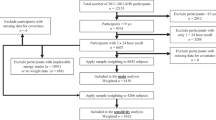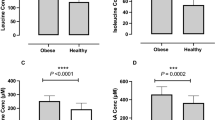Abstract
Objective: To investigate whether subjects consuming a fat-reduced, high-simple carbohydrate diet (SCHO) are at greater risk of micronutrient inadequacy than subjects consuming a fat-reduced, high-complex carbohydrate (CCHO) or a normal-fat diet (control, CD).
Design: A 6-month randomised controlled dietary intervention trial with a parallel design.
Methods: In total, 46 overweight (BMI: 24.4–36.3 kg/m2) subjects (19 males, 27 females) aged 21–54 y consumed one of three ad libitum diets: SCHO, CCHO, or CD. Nutrient intake was assessed by a 7-day weighed food record.
Results: Self-reported energy intake did not differ between diet groups. The lowest intake of vitamin B12 was found in the SCHO group vs CCHO (P=0.025) and vs. CD (P=0.012). In men, zinc intake was lower on the SCHO diet compared to the CD diet (P=0.018). The recommendations for zinc and vitamin B12 were, however, met by all the diet groups. No other diet differences were observed. Intake of several micronutrients were insufficient in all three diet groups, although in most cases comparable to average Danish intakes.
Conclusion: Zinc intake in men and vitamin B12 intake in the combined gender groups were lower on a fat-reduced, simple carbohydrate-rich diet compared to a habitual, normal-fat diet, but not below recommended levels.
Sponsorship: The EU-FAIR program (PL 95-809), the Sugar Bureau, the European Sugar Industries, the Danish Medical Research Council, and the Danish Research and Development Programme for Food Technology.
This is a preview of subscription content, access via your institution
Access options
Subscribe to this journal
Receive 12 print issues and online access
$259.00 per year
only $21.58 per issue
Buy this article
- Purchase on Springer Link
- Instant access to full article PDF
Prices may be subject to local taxes which are calculated during checkout


Similar content being viewed by others
References
Astrup A & Raben A (1996): Mono- and disaccharides: nutritional aspects. In Carbohydrates in Food, ed. AC Eliasson, pp 159–189. New York: Marcell Dekker Inc.
Baecke JAH, Burema J & Frijters JER (1982): A short questionnaire for the measurement of habitual physical activity in epidemiological studies. Am. J. Clin. Nutr. 36, 936–942.
Bandini LG, Schoeller DA, Cyr HN & Dietz WH (1990): Validity of reported energy intake in obese and nonobese adolescents. Am. J. Clin. Nutr. 52, 421–425.
Beerman KA & Dittus K (1993): Source of error associated with self-reports of food intake. Nutr. Res. 13, 765–770.
Bolton-Smith C (1996): Intake of sugars in relation to fatness and micronutrient adequacy. Int. J. Obes. Relat. Metab. Disord. 20 (Suppl 2), S31–S33.
Cohen AM, Bavly S & Poznanski R (1961): Change of diet of Yemenite Jews in relation to diabetes and ischæmic heart disease. Lancet 2, 1399–1401.
Cohen AM & Teitelbaum A (1966): Effect of different levels of protein in ‘sucrose’ and ‘starch’ diets on the glucose tolerance and growth. Metabolism 15, 1034–1038.
DH (1989): Dietary sugars and human disease. Committee on Medical Aspects of Food Policy. Report on health and social subjects no. 37. London: Her Majesty's Stationery Office, Department of Health.
FAO/WHO/UNU (1985): Energy and protein requirements. Report of a joint FAO/WHO/UNU Expert Consultation. Technical Report Series no. 724. Geneva: World Health Organization.
Fricker J, Baelde D, Igoin-Apfelbaum L, Huet JM & Apfelbaum M (1992): Underreporting of food intake in obese ‘small eaters’. Appetite 19, 273–283.
Gibney M, Sigman-Grant M, Stanton Jr JL & Keast DR (1995): Consumption of sugars. Am. J. Clin. Nutr. 62 (Suppl), 178S–194S.
Gibson SA (1997): Do diets high in sugars compromise micronutrient intakes? Micronutrient intakes in the Dietary and Nutritional Survey of British Adults according to dietary concentration of ‘added’, ‘non-milk extrinsic’ or ‘total’ sugars. J. Hum. Nutr. Diet. 10, 125–133.
Goris AHC, Westerterp-Plantenga MS & Westerterp KR (2000): Undereating and underrecording of habitual food intake in obese men: selective underreporting of fat intake. Am. J. Clin. Nutr. 71, 130–134.
Heitmann BL & Lissner L (1995): Dietary underreporting by obese individuals — is it specific or non-specific?. BMJ 311, 986–989.
Heitmann BL, Lissner L & Osler M (2000): Do we eat less fat, or just report so? Int. J. Obes. Relat. Metab. Disord. 24, 435–442.
Lissner L, Habicht J-P, Strupp BJ, Levitsky DA, Haas JD & Roe DA (1989): Body composition and energy intake: do overweight women overeat and underreport? Am. J. Clin. Nutr. 49, 320–325.
Lukaski HC, Bolonchuk WW, Hall CB & Siders WA (1986): Validation of tetrapolar bioelectrical impedance method to assess human body composition. Am. J. Physiol. 60, 1327–1332.
NCM (1996): Nordic nutrition recommendations. Nordic Committe on Foods. Report 28. Copenhagen: Nordic Council of Ministers.
NFA (1987): Danish dietary habits 1985, 2. Who eats what? (in Danish with an English summary). Publication no. 154, pp 139–194. Copenhagen: National Food Agency.
NFA (1996): Danish dietary habits 1995 (in Danish with an English summary). Publication no. 235, pp 77–155. Copenhagen: National Food Agency.
Poppitt SD, Swann D, Black AE & Prentice AM (1998): Assessment of selective under-reporting of food intake by both obese and non-obese women in a metabolic facility. Int. J. Obes. Relat. Metab. Disord. 22, 303–311.
Prentice AM, Black AE, Coward WA, Davies HL, Goldberg GR, Murgatroyd PR, Ashford J, Sawyer M & Whitehead RG (1986): High levels of energy expenditure in obese women. BMJ 292, 983–987.
Raben A, Macdonald I & Astrup A (1997): Replacement of dietary fat by sucrose or starch: effects on 14 d ad libitum energy intake, energy expenditure and body weight in formerly obese and never-obese subjects. Int. J. Obes. Relat. Metab. Disord. 21, 846–859.
Rugg-Gunn AJ, Hackett AF, Jenkins GN & Appleton DR (1991): Empty calories? Nutrient intake in relation to sugar intake in English adolescents. J. Hum. Nutr. Diet. 4, 101–111.
Ruxton CHS, Garceau FJS & Cottrell RC (1999): Guidelines for sugar consumption in Europe: is a quantitative approach justified? Eur. J. Clin. Nutr. 53, 503–513.
Saris WHM, Astrup A, Prentice AM, Zunft HJF, Formiguera X, Verboeket-van de Venne WPHG, Raben A, Poppitt SD, Seppelt B, Johnston S, Vasilaras TH & Keogh GF (2000): Randomized controlled trial of changes in dietary carbohydrate/fat ratio and simple vs complex carbohydrates on body weight and blood lipids: the CARMEN study. Int. J. Obes. Relat. Metab. Disord. 24, 1310–1318.
Skov AR, Toubro S, Raben A & Astrup A (1997): A method to achieve control of dietary macronutrient composition in ad libitum diets consumed by free-living subjects. Eur. J. Clin. Nutr. 51, 667–672.
van Erp-Baart AMJ, Saris WHM, Binkhorst RA, Vos JA & Elvers JWH (1989): Nationwide survey on nutritional habits in elite athletes. Part II. Mineral and vitamin intake. Int. J. Sports Med. 10 (Suppl 1), S11–S16.
Vasilaras TH, Raben A, Lindeløv TS & Astrup A (1997): Self-reported energy intake including data from a shop system corresponds to estimated energy needs in obese subjects. Int. J. Obes. Relat. Metab. Disord. 21 (Suppl 2), S69 (abstract).
Vasilaras TH, Raben A & Astrup A (2001): Twenty-four hour energy expenditure and substrate oxidation before and after 6 months' ad libitum intake of a diet rich in simple or complex carbohydrates or a habitual diet. Int. J. Obes. Relat. Metab. Disord. 25, 954–965.
Vasilaras TH, Raben A, Bülow J & Astrup A (2003): Changes in bone mineral content body weight and body composition following 6 months' ad libitum intake of a diet rich in simple or complex carbohydrates. In preparation.
Willett W (1990): Implications of total energy intake for epidemiologic analyses. In Nutritional epidemiology, ed. W Willett, pp 245–271. New York: Oxford University Press.
Yudkin J (1964): Dietary fat and dietary sugar in relation to ischcemic heart-disease and diabetes. Lancet 2, 4–5.
Acknowledgements
We gratefully thank the participants, the project staff of the Department of Human Nutrition, as well as the food sponsors for kindly contributing to the food selection.
Author information
Authors and Affiliations
Contributions
Guarantor: A Raben.
Contributors: All investigators contributed to the concept and planning of the study. THV did the statistical analysis. THV wrote the first draft of the paper. All investigators contributed to subsequent drafts of the paper.
Corresponding author
Appendices
Appendix A
List of food items available from the experimental shop according to diet group is given in Table A1.
Appendix B
An example of a typical day-menu according to diet group is given in Table B1. Meals include food items from the shop supplied by self-selected foods bought in conventional supermarkets. Also listed is the macronutrient composition for each menu corresponding to an energy content of 10 MJ.
Rights and permissions
About this article
Cite this article
Vasilaras, T., Astrup, A. & Raben, A. Micronutrient intake in overweight subjects is not deficient on an ad libitum fat-reduced, high-simple carbohydrate diet. Eur J Clin Nutr 58, 326–336 (2004). https://doi.org/10.1038/sj.ejcn.1601785
Received:
Revised:
Accepted:
Published:
Issue Date:
DOI: https://doi.org/10.1038/sj.ejcn.1601785



